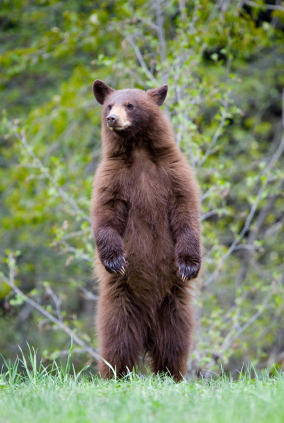Bear habitat
 Black bears occupy a variety of habitat; however, bear populations are densest in forested areas with a wide variety of seral stages. habitats with both vegetative and structural diversity provide alternate food resources when other foods are in short supply. Montane hardwood, montane chaparral, and mixed conifer forests sustain high bear populations because they supply sufficient food, cover and water. Other habitat types, such as valley foothill hardwood, provide seasonally important habitat. Some black bears are even known to use annual grasslands sporadically during the year. Black bears occupy a variety of habitat; however, bear populations are densest in forested areas with a wide variety of seral stages. habitats with both vegetative and structural diversity provide alternate food resources when other foods are in short supply. Montane hardwood, montane chaparral, and mixed conifer forests sustain high bear populations because they supply sufficient food, cover and water. Other habitat types, such as valley foothill hardwood, provide seasonally important habitat. Some black bears are even known to use annual grasslands sporadically during the year.
Food preferences
Bears commonly consume ants and other insects in summer, but prefer nut crops, especially acorns, and manzanita berries in the fall. As omnivores, black bears and will eat whatever seems edible. Mostly they are plant eaters, but they have been reported catching and consuming young deer fawns. Bears frequently adapt to human presence, often because bears are attracted to human garbage, pet food and other food items. In suburban areas and mountain communities, bears may damage private property while foraging. These events are most likely to occur in spring if natural foods are scarce, or in late summer and fall, especially during years of poor berry and acorn yields
Hibernation
Once a black bear begins hibernating, it can doze for many months with a body temperature of 88°F or higher, which is within 12°F of summer body temperature levels By contrast, the body temperature of smaller hibernators such as marmots, chipmunks, and ground squirrels may drop below 40°F. These smaller creatures are known as the “true hibernators” while bear inactivity has been termed “seasonal lethargy.” For simplicity, we will refer to the inactivity of bears during the winter as hibernation.
Bears can go on slumbering because their warm pelts, lower tendency to lose heat, and large body mass allow them to better retain body heat. This, in turn, enables them to cut their metabolic rate in half. Black bears keep their heads and torsos warm enough during hibernation that they can wake if disturbed, although they require a few minutes to awaken.
During hibernation, black bears live off their own fat, their cholesterol levels are more than twice what they are in summer (more than twice as high as most people). But bears show no signs of hardening of the arteries or the formation of cholesterol gallstones. Research has shown that hibernating bears generate a form of bile acid that, when administered to people, dissolves gallstones, eliminating the need for surgery. Weight loss during hibernation is extreme. Male black bears will typically drop between 15 and 30 percent of their body weight, while reproductive sows can lose up to 40 percent. Despite this grave weight loss, over 90 percent of black bears survive the winter.
Bears appear to maintain their muscle mass and tone during the three to four month hibernation period. Even though they are meeting all their energy requirements by metabolizing fats, they do not lose muscle in the process. They seem to be able to use urea (a nitrogen-rich waste product in the blood) to make new protein. For humanity, unlocking this biochemical mystery would greatly assist with dieting and long term fasting to lose weight.
Bears possess another fascinating physiological adaptation, the ability to re-building bones during hibernation. Bears regenerate and repair bones by a mysterious mechanism that researches hope may someday help give us a cure for degenerative arthritis and other bone diseases.
Behavior
Because of their very short tails and long hair, bears cannot use tail or torso to send signals through body language as some other creatures do. This may explain why the head, neck and mouth are used so much to communicate. Walking with head held below the shoulders is likely to result in some type of aggressive behavior. A whole range of facial and mouth expressions are used to intimidate one another including snarling, opening and closing the mouth rapidly while salivating, bearing teeth and making chomping (clacking) noises often indicate an agitated bear. A bear will sometimes bluff-charge an intruder by running full speed at the intruder and stopping just short. This is usually in a strong signal for the intruder to leave the area.
As additional studies reveal greater insight into bears, their habits, habitat needs and physiological composition, Department of Forestry and Game biologists expect to see improvements in management and better understanding in situations involving human-bear interaction and co-existence. |